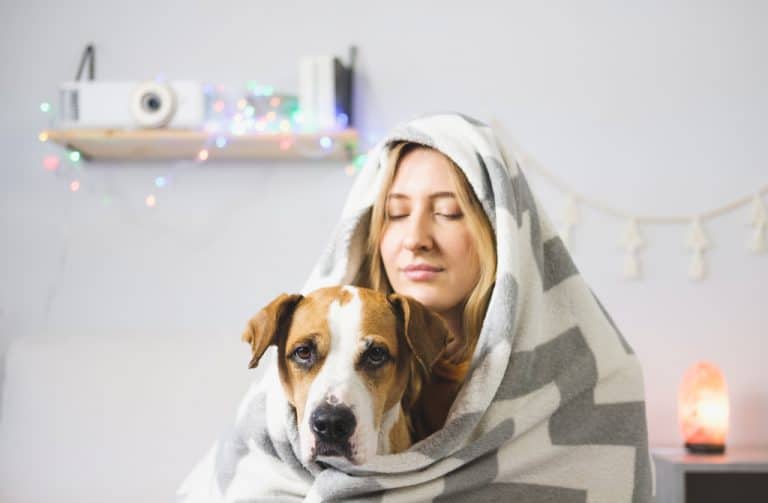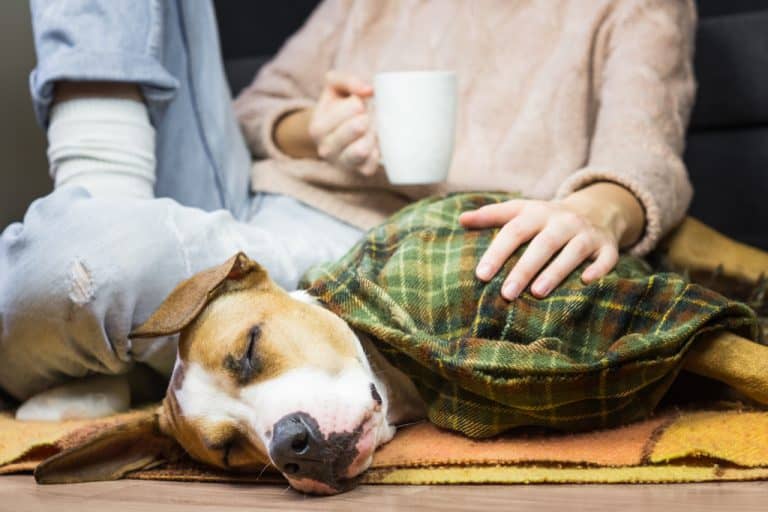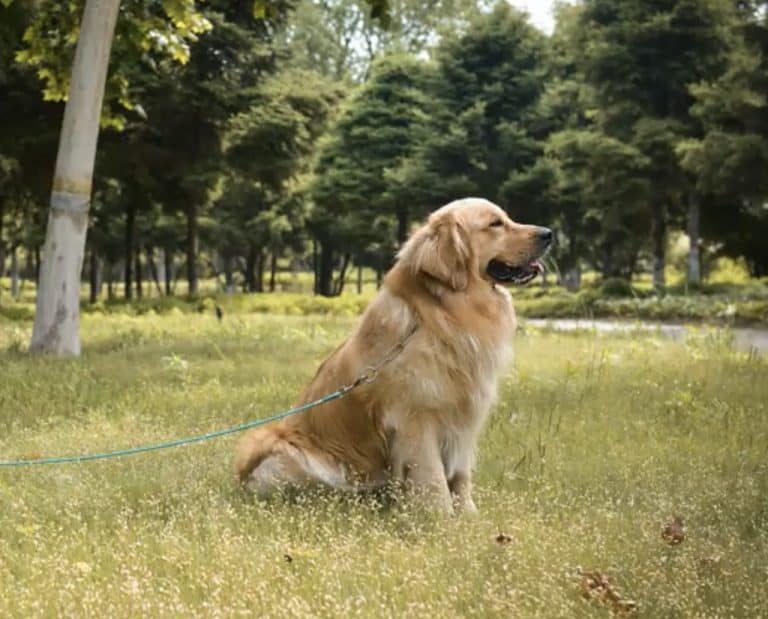Whether your dog is injured, neutered, or spayed, they will need a dog cone to help with recovery.
While no dogs would enjoy wearing cone collars, these medical devices play an essential role in wound healing.
They can keep your canine from biting, chewing, scratching, or excessively licking at the wound, surgical incision, or other irritated areas to prevent further injury.
Below, we’ll discuss what a cone collar is and the alternatives you can consider.
We’ve also rounded up the five best dog cones and alternatives, explains why your dog needs one, broken down things you need to think about before purchasing, and what you can do if your fido hates wearing a recovery collar.
| Types of E-Collars | Product | Our Reviews |
|---|---|---|
| Best Dog Cone | IN HAND Adjustable Pet Recovery Dog Cone | 4.6 out of 5.0 stars4.6 |
| Best Soft E-Collar | All Four Paws The Comfy Cone | 4.5 out of 5.0 stars4.5 |
| Best Inflatable E-Collar | KONG Cloud E-Collar for Dogs and Cats | 4.9 out of 5.0 stars4.9 |
| Best Dog Neck Collar | BiteNot Collar | 4.8 out of 5.0 stars4.8 |
| Best Surgical Recovery Suit | Suitical Recovery Suit for Dogs | 4.7 out of 5.0 stars4.7 |
** Best Dog Cone Collar and Elizabethan Collar Alternatives
Read More:
Quick Picks: Best Dog Cone Collars and Alternatives
What is a Cone Collar for Dogs?
Dog cone collars are also known as Elizabethan collars or E-Collars for short, buster collars, or pet cones. They are also called a recovery collar, pet lamp-shade, pet radar dish, dog-saver, or con of shame. However, the term “E-Collar” is slowly falling out of use recently as it also stands for an electronic collar.
The cone collars are a protective medical device shaped like a truncated cone designed to keep dogs who suffer from hot spots, got injured, or just had surgery from reaching the inflamed skin, stitches, or wounds with their mouth. That way, dogs won’t be able to lick their irritated skin or bite through sutures and worsen the areas of concern.
But because of how a cone of shame is shaped, it will block a dog’s peripheral vision to some extent, causing them to become anxious or have difficulty navigating. And because these barrier devices are hard plastics, some canines hate wearing one and might object by refusing to eat or drink, especially those who are fearful or shy.
Dog Cone Collar Alternatives
1. Soft E-Collars
A soft E-Collar resembles a plastic cone’s shape, made of fabric with a bit of plastic or cardboard for reinforcement. Usually covered with padded materials to provide additional comfort and is less likely to irritate the skin, meaning it is ideal for dogs with sensitive skin.
The problem with this type of collar is that it is only suitable for less active dogs who won’t try to lick or chew too eagerly due to its flexibility. And it is also not a good option for nervous dogs as it will interfere with the dog’s peripheral vision.
2. Inflatable Collars
An inflatable collar looks like a neck pillow we use on airplanes. It has an inflatable bladder inside, covered with a comfortable material, and usually comes with a strap to keep the collar in place. It won’t block the dog’s peripheral vision and is the most comfortable option of the four basic designs.
However, we don’t recommend it for constant wear. The reason is that dogs will have increased mobility and may still be able to reach their wounds. That also means it is only suitable for use on dogs with upper-body injuries, and it’s a good idea to supervise them when they have it on the first time to make sure they won’t be able to reach the areas that need protection.
3. Neck Collars
A neck collar looks like a human neck brace, typically made of flexible plastic and foam designed to keep dogs from bending their necks to lick or bite the wounds. It will restrict more movement than inflatable collars and won’t obstruct the dog’s views.
The downside of this type of recovery collar is that it doesn’t protect the dog’s face and ears, plus dogs can still reach the lower portions of their front legs. And some canines may behave erratically due to the lack of neck movement. It is also not suitable for dogs with short necks like pugs and is not the best option for long-haired dogs like Bernese Mountain Dogs as the skin under the collar may become hot and uncomfortable for them.
4. Surgical Recovery Suits
Surgical recovery suits are essentially just a shirt covering the body and surgical sites without hindering the dog’s peripheral vision. It has comprehensive coverage and is best suited for dogs who hate having anything secured around their necks whatsoever.
The disadvantage of this cone of shame alternative is that it is only suitable for wounds that can be covered by the fabric. It is also not an ideal option for aggressive chewers or scratchers as they can bite or rip the suit apart and access the stitches or wounds. Plus, some dogs don’t tolerate clothing.
Best Dog Cone
IN HAND Adjustable Pet Recovery Dog Cone
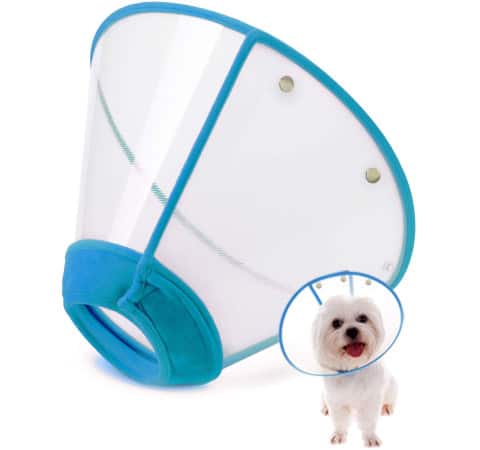
The IN HAND Adjustable Pet Recovery Dog Cone is a vet recommended dog cone and one of the most popular options on the market, offering a safe and humane way of preventing your furry friend from aggravating their healing wound.
It is lightweight and covered with extra soft fabric on edge to ensure it won’t cut into your dog’s skin, with its transparent plastic that will help your fido maintain some peripheral vision so that they won’t feel anxious. It has a combination of unique button closures and velcro closures that make it easy to loosen or tighten and ensure it will stay on.
This ergonomic dog cone is soft and will not scrape your furniture, and you can also put it on your dog while bathing them or trimming their nails to prevent them from biting you.
Features:
- Transparent PVC material
- Padded inner liner
- Ergonomic design
- Button closures and velcro closures
- Vet-recommended
Pros
- Lightweight and durable
- It won’t block your dog’s vision
- Some owners noted that the fabric around the neck area is soft, which allows their dogs to sleep normally without fidgeting around
- Some dogs hate wearing it, especially those who are nervous, fearful, and shy
Best Soft E-Collar
All Four Paws The Comfy Cone
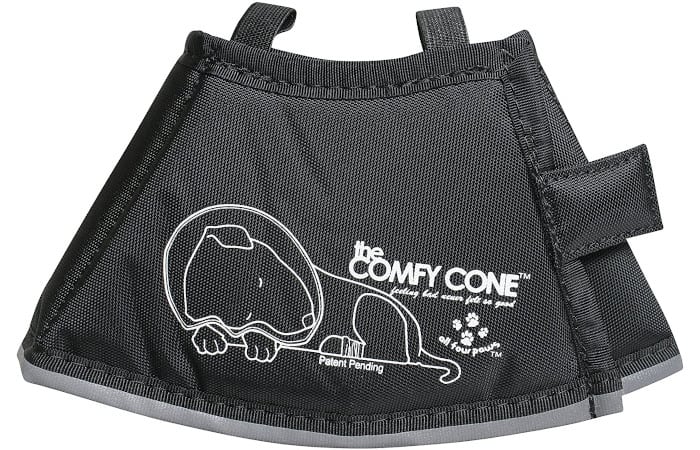
There are many soft E-Collars out there, like the Kong EZ Soft E-Collar for Dogs and Cats. However, the All Four Paws The Comfy Cone is perhaps the best cone of shame alternative and most picked among pet parents, although its solid fabric will inhibit a dog’s peripheral vision. And there’s a good reason for that.
It is a patented soft cone-shaped E-Collar made of foam-backed padded nylon and reflective binding for your dog’s safety. It comes with three sizing strips to ensure a custom fit and velcro closures that make it easy for you to get the cone on and off your pup.
It also has elastic loops at the neck designed to let you thread your dog’s collar through. Plus, the plastic inside is removable, allowing you to alter the rigidity as desired. That also means you will have the ability to fold the edges back to provide your dog with added freedom while eating and drinking.
This soft E-Collar is water-resistant and is easy to wipe clean with a bit of soap and water. We also like that it is reversible, which your furkid can wear inside-out and front-to-back. What’s more, it is veterinarian tested and approved!
Features:
- Patented design
- Foam-backed padded nylon
- Reflective edge
- Three sizing strips
- Velcro closures
- Elastic loops
- Removable plastic
- Water-resistant
- Reversible
- Veterinarian tested and approved
Pros
- Most owners reported that their dogs seemed to find it much more comfortable than the traditional stiff plastic cones
- You can remove the plastic for flexibility or keep it in for a firmer structure
- It is one of the most trusted soft E-Collars
- Recommended by veterinarians
- It will interfere with peripheral vision
- Not ideal for determined chewers or lickers
Best Inflatable E-Collar
KONG Cloud E-Collar for Dogs and Cats
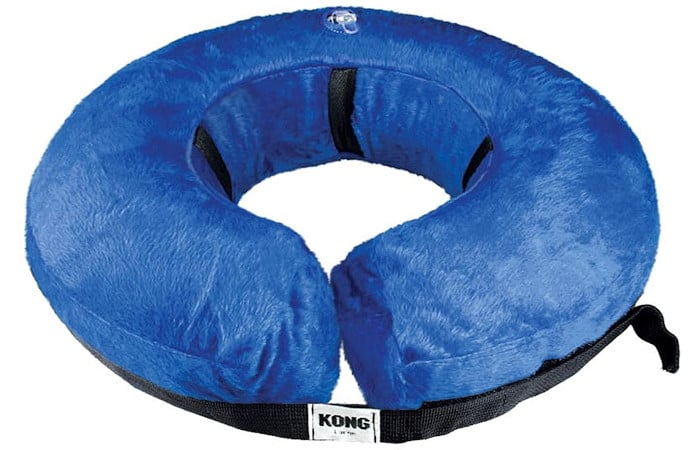
The KONG Cloud E-Collar for Dogs and Cats is an inflatable E-Collar that won’t interfere with your canine’s vision or their ability to eat and drink, making it the least stressful option for dogs.
It inflates into a donut shape and sits around your dog’s neck like a travel pillow, made of durable material that is scratch-resistant and bite-resistant, with an extended hook and loop strap to allow for a wide range of adjustments. It also has a few loops on the inside, which you can thread your dog’s collar through to keep it in place.
Since this E-Collar alternative has a cozy fabric cover, it won’t mark or scratch any of your furniture.
Features:
- Scratch-resistant and bite-resistant material
- Fabric cover
- Long velcro strap
- Inner ring loops
- Machine washable
Pros
- Most comfortable
- Won’t block your dog’s view
- Great for brachycephalic dogs who have trouble wearing cones
- Easy for dogs to get used to
- Your pup won’t bang into walls, stairs, and corners
- Not ideal for constant wear
- Only suitable for use on dogs with upper-body injuries
Best Dog Neck Collar
BiteNot Collar
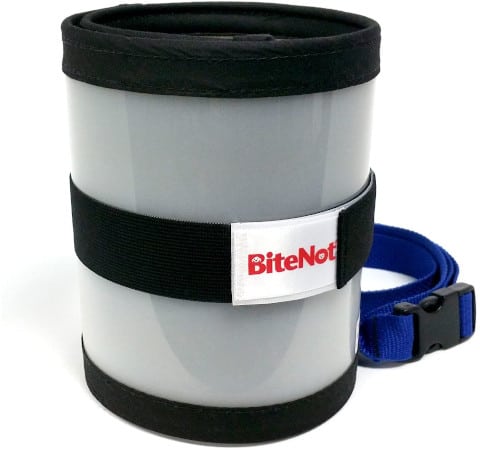
The BiteNot Collar is like a human cervical collar designed to keep dogs from bending their neck, ultimately limiting their ability to get to certain parts of their body, surgical sites, or injured areas.
It is adjustable, made of flexible plastic that wraps around your dog’s neck, and secured by a hook-and-loop closure and a harness strap that goes underneath the front legs and buckles at the back of the neck. That is to prevent it from sliding up on the head and ensure it stays in the place where it belongs. It also has soft edges to keep it from digging into your dog and a foam backing to provide comfort.
This neck control collar can protect a dog’s back, rump, the base of tail, flanks, chest, abdomen, and genitals, but not areas near their face, eyes, and lower portions of their front legs.
Features:
- Flexible plastic
- Foam backing
- Velcro-like closure
- Includes a harness strap
- Machine washable
Pros
- It doesn’t impede vision
- Dogs can eat and drink while wearing this collar
- Less stressful than E-Collars
- Difficult for dogs to wriggle out of it
- It can’t protect your dog’s face, eyes, and ears
- This recovery collar can trap moisture and heat beneath it, which can make it uncomfortable for dogs. That also means you will have to take it off your
Best Surgical Recovery Suit
Suitical Recovery Suit for Dogs
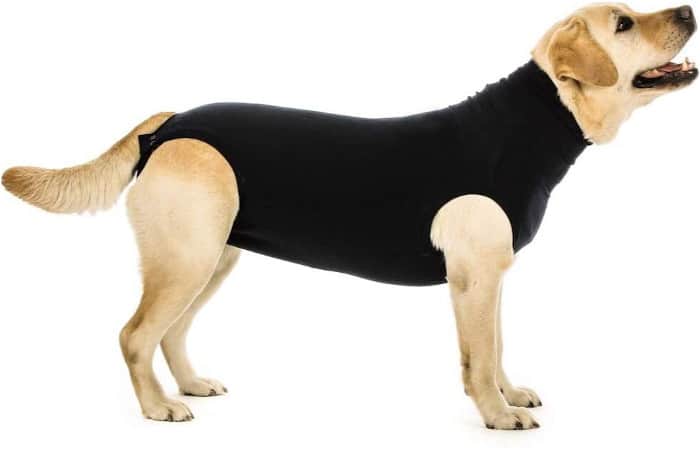
If your pup hates wearing anything around their neck at all, then the Suitical Recovery Suit for Dogs may be the best option.
It is a professional alternative to the medical cone, which works like a full-body shirt that provides comprehensive wound and suture protection. It is made of lightweight and breathable fabric to ensure a high comfort level for stress-free recovery, with a spacious rear opening and press studs to make it easy for you to put on your dog. There are also loops around the neck that you can slip a collar through to make it even more difficult for your fido to squeeze out of it.
Additionally, this protective apparel for dogs has an easy hold-up system, allowing you to roll it up and secure it with press studs for potty breaks. What’s more, it has an inner panel where you can insert a pad for incontinence or estrus.
Features:
- 94% Organic Cotton and 6% Lycra
- Four-way stretch fabric
- Loops around the neck
- Rear fastening design
- Hold-up system
- Inner panel
- Machine washable
- Recommended by veterinarians
Pros
- Lightweight and breathable
- No vision blocked or body movement restriction
- This shirt has a soft, elastic protective band around the neck, tail, and front and hind legs to ensure it won’t rub or cut into your dog
- It is fully closed, which can protect your dog’s entire torso
- Recommended by veterinarians, physiotherapists, groomers, and breeders
- Not suitable for aggressive chewers as they can rip the shirt apart
- It only protects the torso
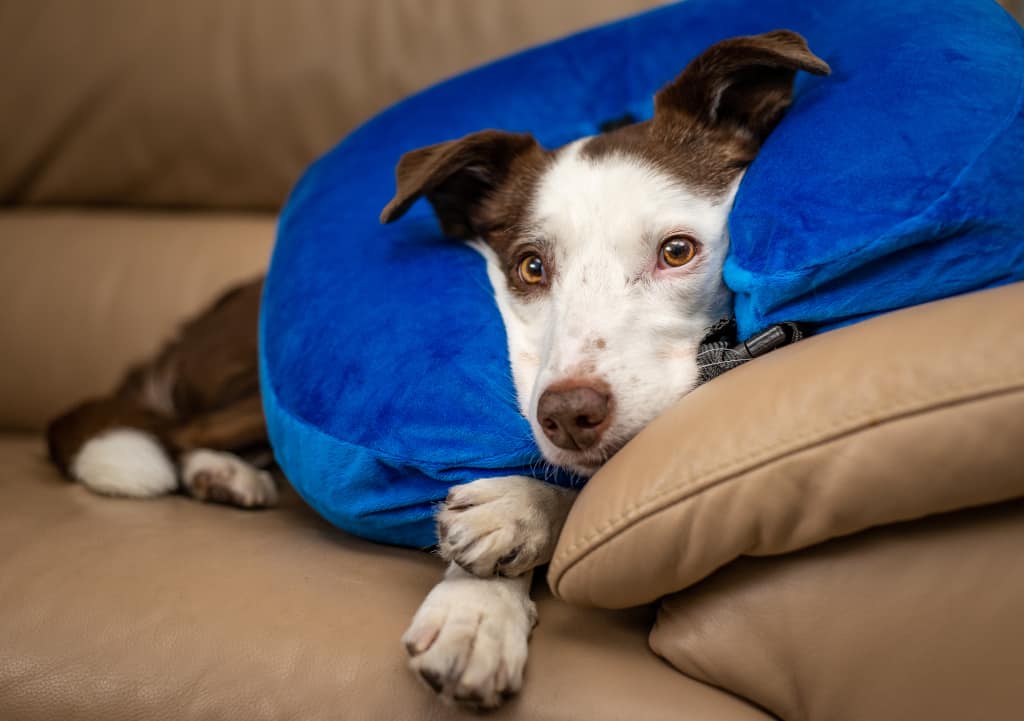
Why Do Dogs Need an E-Collar or a Cone of Shame Alternative?
Following surgery or an injury, dogs will instinctively lick wounds as it is the only thing they know how to soothe the pain and heal themselves. In fact, scientific evidence suggests that dog saliva contains antimicrobial and healing properties, which can help cleanse injured areas and speed up recovery.
While wound licking might offer a few potential benefits, there are many drawbacks to that, and it does more harm than good! Dogs have billions of bacteria inside their mouth that can cause severe infection if introduced into a wound.
Also, the friction caused by licking can break down the tissues and stitches and re-open the incisions or wounds, making the affected area more susceptible to debris and infection, and as a result, slowing down the healing process.
That’s the reason why dogs need an Elizabethan collar or a cone of shame alternative, as these medical devices can keep dogs from excessively licking or chewing at a wound, surgery site, or dressing. In fact, veterinarians would often recommend or even send your pup home with an E-Collar, especially after your canine just had surgeries like spaying or neutering.
Dog Cone and Alternatives Buyer’s Guide : What to Consider
Although you usually get a free E-Collar from the veterinarian, it is typically an inexpensive and rigid type. So it’s a better idea to get your four-legged friend a more comfortable version. And when it comes to upgrading it, there are a few things you need to consider. Here are some of them.
1. Where is the wound located?
Not all dog cones and alternatives are created equal. Some like the IN HAND Adjustable Pet Recovery Dog Cone and All Four Paws Comfy Cone can prevent your dog from reaching most of their body parts, while the KONG Cloud E-Collar for Dogs and Cats is only best suited for dogs who have upper-body injuries. So you would want to make sure the device you are getting can cover the wound or surgery site you are trying to protect.
2. What are the things that will irritate or frighten your dog?
Keep the things that will irritate or scare your dog in mind. Some canines are afraid of sudden banging caused by hard plastics, some are easily frightened by velcro’s sound, and some will become hypersensitive if their vision is limited. You would want to avoid buying recovery collars that can cause your furkid to become anxious or fearful as the stressors can slow down healing.
3. Traits of your dog you should also factor into the decision.
You will also need to consider your dog’s personality traits before purchasing. If your fido is an aggressive chewer, the Suitical Recovery Suit for Dogs may not be a great option. Likewise, if your dog will go nuts if their vision is blocked, then you would be better off picking devices like the BiteNot Collar and KONG Cloud E-Collar for Dogs and Cats.
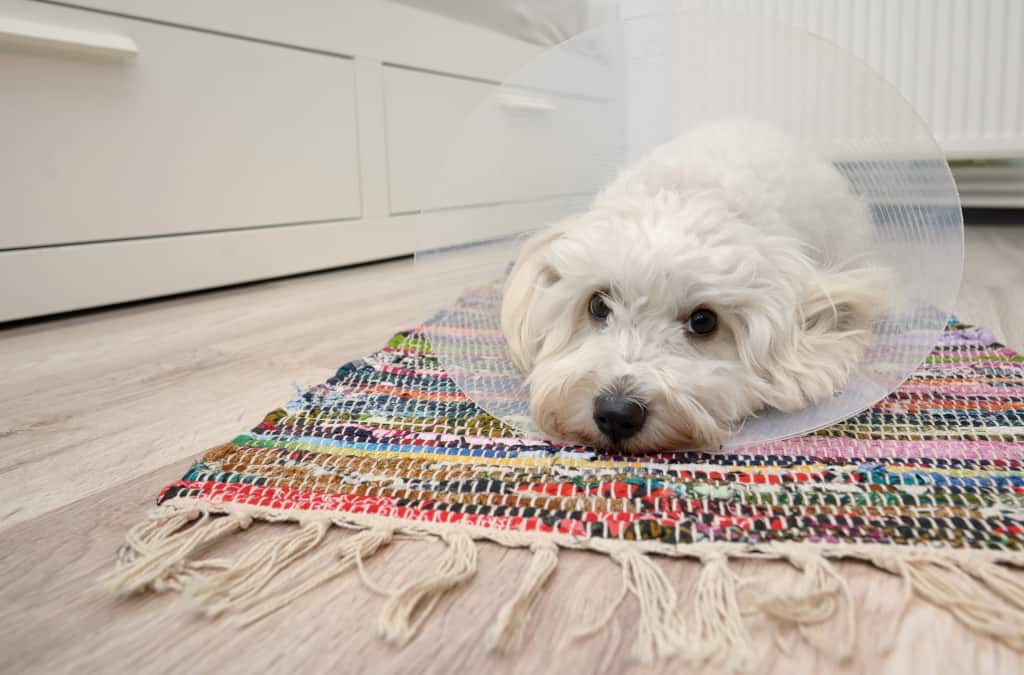
What Can You Do if Your Furry Friend Hates Wearing the Cone of Shame?
Some dogs can tolerate cone collars quite well, but most hate wearing one! And if your dog is the latter, below are some of the things you can try to do.
1. Ensure the recovery collar fits well.
Always make sure you get an appropriately sized collar that fits well on your four-footed friend. Otherwise, it may rub against your dog’s skin and cause sores and abrasions, which can be very uncomfortable for them, and they will most likely refuse to wear it.
2. Help your dog to navigate.
If you are getting your canine a protective device that will interfere with their peripheral vision, they may have difficulty navigating at first. So you would want to help your pup navigate, which includes assisting your dog up and down the stairs and through doorways until they get used to walking with their impeded vision.
3. Be more consistent and praise your dog when they demonstrate good behavior with their cone collar.
The more often you take the cone collar down from your dog, the slower they become accustomed to wearing one. So, just put it on your dog and leave it there. You would also want to praise your pup when they show positive behavior with the protective collar, as constant praises will encourage more good behavior from them.
4. Introduce your dog to the cone or the E-Collar alternative before they need one.
It’s also a good idea to introduce your furkid to the cone or the E-Collar alternative and let them familiarize themselves with it before they have to put it on. That way, you can help reduce some of your dog’s anxiety as you are not forcing them to use the device, plus they will also be more willing to wear it!
5. Try different types of protective devices.
Some dogs might hate wearing a traditional Elizabethan collar but don’t mind wearing protective clothing. Your dog is no different, in which they may respond better to some recovery collars than others.
Homemade Dog Cone Collars
Making your DIY dog cone or E-Collar alternative isn’t too complicated. If you are interested in creating your own, here are some guides to help you get started.
DIY #1: Bucket Cone
As its name indicates, this cone collar is made from a bucket, and that is something you already have at home. However, it is a bit bulky compared to other options and is relatively harder to make as you have to cut a hole in the bottom of the bucket.
You will also need to poke a few small holes around the opening just so that you can thread zip ties or twine through to attach it to your dog’s collar and hold it in place. One thing, though, make sure to sand down the rough edges before putting it on your dog to prevent any injuries. Can’t visualize it? You can read more about this DIY collar with a step-by-step guide and photos here.
DIY #2: Cardboard Elizabethan Collar
Another option you have is a cardboard E-Collar. First, you will need a square piece of cardboard and divide it into eight triangular parts with a pen. Next, draw an outer circle with a compass, which the radius depends on your dog’s size. Once you’ve finished drawing it, cut off the remaining cardboard.
Then, measure your dog’s neck (or use your dog’s collar as a guide) and cut the inner circle with a box cutter, and you should have a donut-shaped piece of cardboard. After that, make a cut on one side so that you can adjust the size and tape the inner part to prevent the collar from cutting your fido. Lastly, secure the two ends of the collar with a strong adhesive tape. You can also check out the video below to learn how to make one.
DIY #3: Towel Collar
A towel collar is perhaps the easiest one to make. All you need is simply a comfortable towel that you can fold into thirds and wrap around your dog’s neck, and some duct tape to secure it. Just make sure that the collar isn’t too tight or too loose. For large dogs, you should be able to fit your hand in between the towel and their neck and at least two or three fingers for small dogs.
DIY #4: Custom Post Surgery Shirt
Or you can also use an old T-shirt to make your dog a protective garment. You will need to cut out a large square of the fabric and four holes for your dog’s paws. Once you’ve done that, get your pup to step in all four holes and fasten it with safety pins!
Dog Recovery Collar FAQ
1. How do I stop my dog from bumping into things when wearing an E-Collar?
To stop your dog from running into walls, stairs, and furniture, you will need to guide them around the house for the first few days and let them get accustomed to how these devices change their ability to move. It is also a good idea to make more space for them by removing unnecessary obstacles in your home. That way, they won’t bang into things that they can’t see and scare themselves.
2. Can my pup eat and drink while wearing a cone?
Your dog shouldn’t have any trouble eating or drinking if you picked a correctly sized recovery collar. But if, for some reason that, your canine can’t reach the food or water bowl, you will need to use an elevated bowl instead, or you would have to take the cone off during breaks and keep an eye out on them to make sure they don’t chew or lick at their wounds or incisions.
3. How long does my dog need to wear a cone collar after being neutered or spayed?
You will have to follow your vet’s advice. That said, dogs will usually need to wear a cone of shame or an E-Collar alternative for about two weeks or so to heal completely.
4. Can my dog sleep with an E-Collar on?
Yes, your dog can sleep with an E-Collar on. In fact, being consistent and leaving the device on your dog at all times can quickly help your pup get used to it, which also ensures that they can heal fast.
5. Do I need to clean the recovery collar?
Yes, it is crucial to keep the dog cone collar clean to prevent skin infections. So it’s a good idea to wipe it with a damp cloth daily, or you can also use soap and warm water to clean it and make sure to dry it thoroughly before putting it back on your dog.

